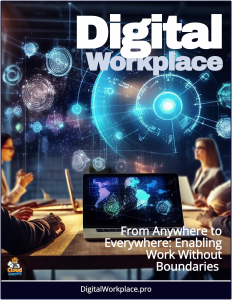Remote Work Trends Shaping the Digital Workplace in 2025
Remote work is no longer a temporary response to global events but a cornerstone of the modern digital workplace.
 The landscape of remote work continues to evolve rapidly, driven by technological advancements, shifting employee expectations, and organizational imperatives.
The landscape of remote work continues to evolve rapidly, driven by technological advancements, shifting employee expectations, and organizational imperatives.
Remote work is no longer a temporary response to global events but a cornerstone of the modern digital workplace.
Below are the key trends defining remote work today, reshaping how organizations operate and employees thrive in a boundaryless world.
Hybrid Work Models Dominate
Hybrid work, blending remote and in-office work, has become the preferred model for many organizations. Companies are adopting flexible policies that allow employees to split their time between home, office, and co-working spaces.
This approach balances collaboration and face-to-face interaction with the autonomy of remote work. Recent data suggests that 60% of global companies have implemented hybrid models, with employees typically spending 2-3 days in the office. Tools like scheduling apps and desk-booking systems are critical to managing hybrid environments, ensuring seamless transitions between work settings.
AI and Automation Enhance Productivity
Artificial numbArtificial intelligence and automation are transforming remote work by streamlining tasks and boosting efficiency. AI-powered tools, such as virtual assistants and transcription services, help remote workers manage schedules, summarize meetings, and analyze data in real time.
Automation platforms handle repetitive tasks like data entry or report generation, freeing employees to focus on high-value work. For example, AI-driven analytics tools can provide insights into customer behavior or project timelines, enhancing decision-making for distributed teams. Organizations are increasingly integrating these tools into platforms like Slack or Microsoft Teams to support seamless remote workflows.
Focus on Employee Well-Being and Engagement
With remote work, concerns about burnout and isolation have intensified, prompting organizations to prioritize employee well-being. Companies are implementing wellness programs, mental health resources, and flexible schedules to combat digital fatigue.
Virtual team-building activities, such as online escape rooms or coffee chats, are gaining traction to foster connection among distributed teams. Data indicates that 70% of remote workers report feeling disconnected at times, pushing employers to create virtual communities through regular check-ins and recognition programs to maintain a strong culture.
Advanced Cybersecurity Measures
As remote work expands, so do cybersecurity risks. With employees accessing sensitive data from diverse locations and devices, organizations are adopting zero-trust security models, multi-factor authentication, and end-to-end encryption. Regular cybersecurity training is now standard to educate employees on phishing and data protection. Recent reports highlight that 80% of data breaches involve compromised credentials, underscoring the need for robust security protocols in remote environments. Compliance with regulations like GDPR and CCPA remains a priority to balance security with employee privacy.
Global Talent Acquisition and Inclusivity
Remote work has unlocked access to global talent, allowing organizations to hire skilled professionals regardless of location. This trend has increased workforce diversity, with companies leveraging platforms like LinkedIn and Upwork to source talent from different regions.
Inclusivity is a key focus, with organizations ensuring equal access to opportunities and resources for all employees, regardless of background or location. This shift has led to a 30% increase in cross-border hiring since 2020, according to industry surveys, enriching team perspectives and innovation.
Immersive Collaboration Technologies
Emerging technologies like the metaverse and augmented reality (AR) are redefining remote collaboration. Virtual reality platforms enable immersive meeting spaces where teams can interact as if in the same room. Tools like spatial whiteboards and AR prototypes allow for real-time co-creation across time zones.
For instance, a designer in one country can share a 3D model with a colleague elsewhere, enhancing creative workflows. Adoption of these technologies is growing, with 25% of enterprises experimenting with metaverse-based collaboration tools in 2025.
Flexible Workspaces and Co-Working Hubs
The rise of co-working spaces caters to remote workers seeking community and infrastructure outside traditional offices. Platforms like WeWork and local hubs offer flexible desks and high-speed internet, bridging the gap between home and office. These spaces are particularly popular among hybrid workers, with 40% of remote employees using co-working facilities at least occasionally, according to recent studies. This trend supports productivity while addressing the isolation often associated with fully remote setups.
Sustainability and Cost Efficiency
Remote work continues to deliver cost savings for both organizations and employees. Companies are reducing expenses on office spaces and utilities, while employees save on commuting costs. Additionally, remote work aligns with sustainability goals, cutting carbon emissions from daily commutes.
Studies estimate that widespread remote work has reduced workplace-related emissions by 15% in some regions since 2020. These savings are reinvested into digital infrastructure and employee development, further strengthening the remote work ecosystem.
Challenges and Solutions
Despite its benefits, remote work faces challenges like collaboration gaps and cultural disconnect. Miscommunication can hinder teamwork, but intuitive tools and structured virtual interactions help bridge this gap. Regular feedback loops and analytics to track engagement ensure continuous improvement. Organizations are also addressing digital overload by promoting boundaries, such as “no-meeting” days, to support work-life balance.
The Future of Remote Work
The future of remote work is boundless, with trends pointing toward even greater integration of AI, immersive technologies, and global talent pools. As organizations refine hybrid models and invest in employee-centric strategies, the digital workplace will continue to evolve, enabling work that is not just from anywhere, but truly everywhere.



